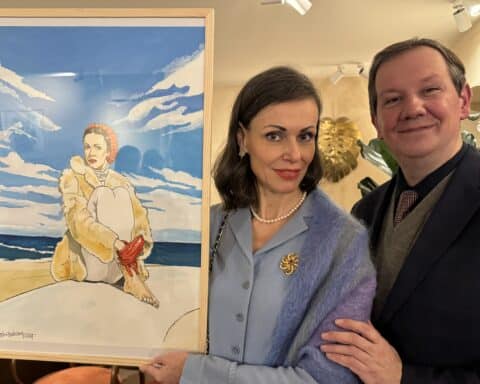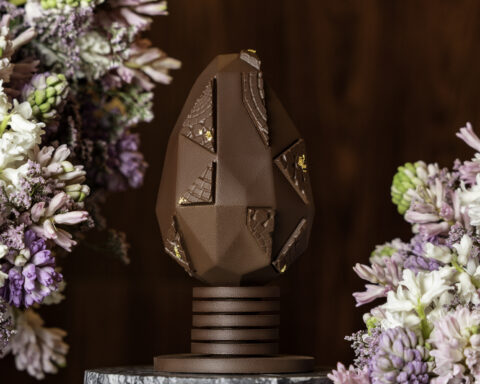Born in 1906 into a poor family in Missouri, in a country riddled with segregation, nothing predestined Josephine Baker to become a feminist icon celebrated in Paris and ”beyond the seas.” A dancer, singer, revue leader, and resistance fighter, she remained true to her commitment to universalism and her fight against racism.
While Paris is inseparable from the Eiffel Tower and Edith Piaf, what would the City of Light be without Josephine Baker’s ultimate declaration of love in the song “J’ai Deux Amours”? Yet the freedom-loving artist who made a name for herself in the French capital with her exotic charm and her playful and scandalous dances was American by birth.
While she could have turned a blind eye to her fellow human beings, Josephine Baker used her fame to support just causes, from fighting the Nazi occupation in her adopted country to campaigning for civil rights alongside Martin Luther King.
2025 marks the 50th anniversary of the death of this inspiring woman, who, entering the Panthéon on November 30, 2021, joined such illustrious figures as Simone Veil, Marie Curie, and Germaine Tillion.
Modest beginnings
If Josephine Baker fascinates people on both sides of the Atlantic, it is primarily because her story is as much an example of a committed personality as it is of the American Dream, having succeeded in rising through hard work, daring, and tenacity. In her case, it is even a story of “rags to riches,” as Americans say.
Freda Josephine McDonald was born on June 3, 1906, into a very poor family in St. Louis, Missouri. Her mother, who was of African-American and Native American descent and the daughter of a slave, was a musician and dancer. Her presumed father was a white itinerant street musician of Spanish origin who abandoned the family without acknowledging the child when Josephine was just one year old.
Her mother then married a laborer with whom she had three children.
Raised in harsh conditions, Josephine was forced to alternate between school and working as a domestic servant for wealthy white families who saw her more as an animal than a human being. The money she earned was used exclusively to feed her siblings, of whom she was the eldest. Nevertheless, little Josephine was able to endure such a situation thanks to her love of dance and her desire to become a star.
At the age of 13, she left school and entered into her first marriage, which lasted only a few months.
First steps on stage
In 1920, she crossed paths with a trio of street performers, the Jones Family Band. As their tour ended in Philadelphia, she met William Howard Baker, whom she married and whose name she took.
To earn a living, she danced at the Standard Theater, where she earned ten dollars a week.
Dreaming of greatness, she eventually left her second husband to seek her fortune on Broadway.
Upon arriving in New York, she soon presented herself at Daly’s 63rd Street Theater, a music hall on 63rd Street. After being rejected several times for being “too short, too skinny, and too dark,” she was hired as a dresser for the tour of the musical Shuffle Along. Thanks to a stroke of luck—a dancer who became pregnant during the show in Chicago was immediately fired—she managed to land a minor role in this show with an exclusively black cast. After two years on tour, she joined another group, the Chocolate Dandies, before moving on to the Plantation Club.
It was there that she made the encounter that would change her life: Caroline Dudley Reagan.
Believing in her great potential, this socialite and wife of the commercial attaché at the US Embassy in Paris, Donald J. Reagan, offered her a salary of $250 a week on one condition: that she follow her to Paris to put on a show that would make her a star: La Revue Nègre.
Paris, 1925
It was the Cubist painter Fernand Léger who suggested to André Daven, administrator of the Théâtre des Champs-Élysées, the idea of putting on a show performed entirely by Black people. It must be said that since the Senegalese riflemen of the First World War, African art, beloved of the Surrealists, had been on the rise in France. Significantly, a short time earlier, in 1921, René Maran from Martinique had won the Prix Goncourt.
On board the Berengaria, a transatlantic liner departing from New York, Joséphine met jazzman and clarinetist Sidney Bechet, one of the twenty-five artists—including twelve musicians—who joined the Revue Nègre adventure.
Although the gloomy weather in Cherbourg dampened her spirits, she was quickly cheered up by the sight of white hands carrying her luggage as she got off the train at Saint Lazare station. As essayist Laurent Kupferman, who was in charge of her Pantheon induction, recalls, “it was the first time she felt she was being looked at as a person and not as a color.”
When she arrived, Paris was in the midst of the Roaring Twenties, when the whole city was one big party and the singer and revue leader Missinguett reigned supreme. But behind the impression of freedom, the audience in cabarets, dance bars, and theaters sought to forget the horror of the Great War and lose themselves in general hysteria.
But the coronation almost never happened: upon its arrival in the City of Light, the Revue Nègre displeased its authors, who perceived it as too prudish, whereas the Parisian public expected African savagery. The show’s star dancer, Josephine Baker, proposed to dance topless. On the evening of the premiere, critics, artists, and socialites turned out in force.
On stage, Josephine played with colonial clichés, interpreting in her own way the image of the beautiful exotic woman stripped naked, wearing only a banana belt. “Dazzled by the spotlights that set me ablaze, driven by some devil I couldn’t name, I improvised to the music, driven mad by the packed theater and the fever that was everywhere, even in my teeth and eyes,” she would later say. Amusing herself by squinting and swaying her hips like no one else, she was by turns clown, seductress, native, and American. “It seemed to me that when I leaped, I jumped into the sky, and when I fell back to earth, it belonged entirely to me.”
While her dances, which catered to bourgeois fantasies, and her haircut (a bob ahead of its time) fascinated audiences, she deeply annoyed conservatives. The press was divided into two camps, with the best—“She is the black Venus who haunted Baudelaire”—alongside the most cruel critics: “La Revue Nègre is a lamentable transatlantic exhibitionism that takes us back to the monkey in less time than it took us to descend from it.” Collecting press clippings, she said that they were her first lessons in French.
Regardless of the naysayers, the public wanted more, and the greatest artists sought her out. The novelist Georges Simenon became her secretary and lover, Paul Poiret dressed her, Collette wrote her letters, Van Dongen sketched her on paper, and Calder sculpted her. It was at this time that she met an Italian adventurer named Pépito, who called himself “Count Giuseppe Abatino,” whom she made her impresario.
A seasoned businessman, he had the idea of targeting female customers. He made Josephine Baker a muse before her time, using her face to sell a bronzing powder (Baker Skin) and a hair gel (Baker Fix). He was also the one who introduced her to the world of cinema.
In 1926, she triumphed at the Folies Bergères theater, and Pepito, her manager, even offered her her own cabaret.
Italy, Sweden, and Germany fought over her, to the point of upsetting the administrator of the Folies Bergères. The artist then negotiated an additional 400 francs per performance for her return to Paris.
And her reunion with the City of Light proved her right when the doors of the Casino de Paris opened in 1930. A year later, she received one of the greatest gifts from composer Vincent Scotto and a staple of her repertoire: the hit song “J’ai Deux Amours”.
The greater good of the homeland
In 1936, Josephine Baker thought she could replicate her Parisian success in the United States.
Performing in the Ziegfried Follies musical hall show, the critics were terrible, reducing her to the status of a “Negress.” In hotels and restaurants, the situation was hardly any better. This phenomenon would repeat itself in the 1950s, when the Stock Club refused to serve her. Bitter and humiliated, she chose to return to France, but upon her return, tragedy awaited her: Pepito, her impresario and lover of ten years, had died in the meantime.
The music hall star dispelled her boredom at gala evenings and official dinners. At one of these, she met Jean Lion, a wealthy industrialist, Jew, and future member of the Resistance, whom she chose to marry on November 30, 1937, as fascism and anti-Semitism were rising in Europe. She then obtained French citizenship. But this domestic life did not suit her and very soon, after the loss of her baby, she decided to divorce and return to the stage.
On the day war was declared on Nazi Germany, September 3, 1939, her sense of duty took over and she decided to serve her adopted country. In front of Captain Jacques Abtey, head of French intelligence, she declared herself ready to give her life for her country. He made her an intelligence agent or “honorable correspondent,” as she preferred to call it.
While touring abroad, she introduced Abtey as her private secretary, gathering information from her encounters in embassies and hotels. Meanwhile, she turned the Château des Milandes in Castelnaud la Chapelle (24), which she had been renting since 1938, into a resistance stronghold, sheltering Jews and resistance fighters. She installed a radio receiver and heard General De Gaulle’s appeal on June 18.
After being spotted, she joined the air force and took refuge in North Africa, where she gave concerts, donating the proceeds to the Free French resistance movement. In 1941, in Casablanca, she suffered a miscarriage. She also became an artisan of soft power for France and General De Gaulle. She thus indirectly encouraged the Allied leaders to recognize the general as the future strongman of the post-war period, rather than Admiral Darlan, who was favored by US President Roosevelt.
Her acts of bravery earned her the Croix de Guerre, the Croix de Lorraine awarded by General De Gaulle, the Resistance Medal with Palm – awarded to only 4,800 people – and the Military Legion of Honor.
When peace returned, she bought the Château des Milandes in 1948, in the heart of the Périgord Noir. The place soon became home to her rainbow tribe, her vision of brotherhood through twelve adopted children of different nationalities, to whom she devoted herself until her death on April 12, 1975.
Thanks to the Milandes, we also owe her a 5-hectare park dedicated to leisure and entertainment. This first French hotel complex included a swimming pool, a golf course, and the first canoes on the Dordogne River. It was a pioneering move that inspired the Trigano brothers to create Club Med.
A timeless example
If Josephine Baker became an icon loved by so many, it was first and foremost because she was a free and courageous woman who remained true to herself and touched people deeply.
The first person to campaign for her to be honored in the Panthéon in 2013, Régis Debré said of Josephine Baker that “she is not a myth but an example.” For essayist Laurent Kupferman, who has since taken up the cause of having her honored in the Panthéon, she was “a profoundly free woman who took control of her destiny. She fought against all the problems she faced in her country.”
A supporter of universalism and a fighter against all forms of discrimination, she was notably involved alongside Claude Pierre-Bloch before the war in what would become the LICRA (International League Against Racism and Anti-Semitism). She also worked for the cause of black people, notably participating in the March on Washington for Jobs and Freedom alongside Martin Luther King in August 1963.
Laurent Kupferman sees her as an illustration of Saint Exupéry’s maxim that “if you are different from me, far from harming me, you enrich me.”
He adds that if her strength remains intact, it is because “the battles she fought are still relevant today.”
Her memory lives on in her château in Les Milandes, which has been turned into a museum dedicated to her life, featuring her stage outfits, including the famous banana belt she wore in her early days. For the past three years, the château has also hosted a literary and music festival on the last weekend of June.
The songs of this unique character have been covered many times in the world of jazz. Her “vocal doubles,” American actress Nicolle Rochelle, French-American singer Cécile McLorin Salvant, and South African opera singer Pretty Yende, have covered “La Petite Tonkinoise,” “Je voudrais être blanche,” and “J’ai deux amours,” respectively. The latter song, a true ode to the love of the City of Light, was used as a teaser by France Télévision for the 2024 Olympic and Paralympic Games in Paris.
After being portrayed by former Miss France Sonia Rolland in Woody Allen’s 2011 film Midnight in Paris, Josephine Baker is set to be in the spotlight once again in 2026 with a documentary by Studiocanal, a TV series, and, most notably, a musical by Jean-Pierre Hadida at Bobino.
Read also > “Châteaux en fêtes” 2024 unveils new hidden treasures in the Dordogne
Featured photo: Josephine Baker in 1936



















